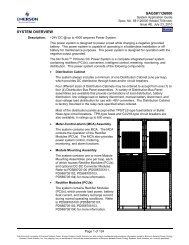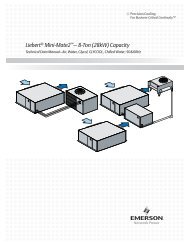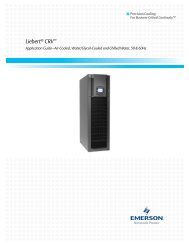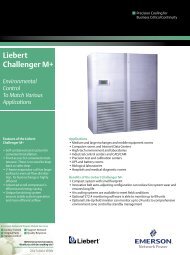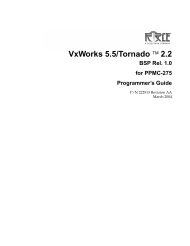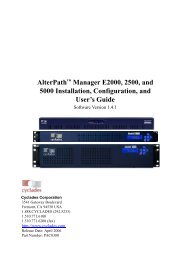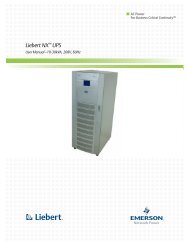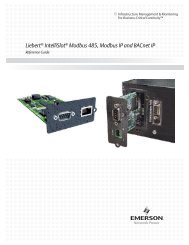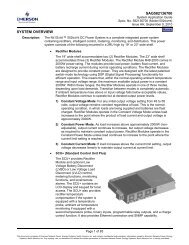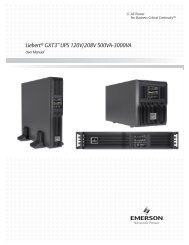DSView⢠4 Installer/User Guide - Emerson Network Power
DSView⢠4 Installer/User Guide - Emerson Network Power
DSView⢠4 Installer/User Guide - Emerson Network Power
You also want an ePaper? Increase the reach of your titles
YUMPU automatically turns print PDFs into web optimized ePapers that Google loves.
66 ����������� � �������������� �����<br />
Property Description<br />
Proxy Server<br />
When the Avocent proxy server is used, DSView software client KVM and serial session<br />
requests are sent through the DSView server rather than directly to the KVM switch or serial<br />
console appliance, which prevents the exposure of the internal address of the managed<br />
appliance. You may change the proxy server configuration. EVR1500 environmental monitor,<br />
DSI5100 IPMI and generic appliance sessions are not sent through the DSView server,<br />
even when the proxy is enabled.<br />
SSH Server Enables/disables the SSH server and specifies the port it uses.<br />
Trap Destinations<br />
DSView Client<br />
Sessions<br />
DSView Modem<br />
Session<br />
Email<br />
Unit Status Polling<br />
The DSView server polls KVM switches or serial console appliances to determine if they are<br />
responding. If the managed appliance does not respond, the DSView server sends an<br />
SNMP Loss Of Communication (LCM) trap or alert to the external SNMP manager. When<br />
the DSView server detects that the appliance is once again communicating, a Regained<br />
Communication (RCM) trap is sent from the DSView software server. When a response<br />
change occurs during communication between the DSView server and a managed appliance,<br />
the DSView software writes the event to the event log and sends an SNMP trap to the<br />
configured trap destinations. Trap destinations may also be specified by clicking on a managed<br />
appliance and changing the SNMP appliance settings.<br />
Settings for inactivity time-out, authentication policy, Single Sign-On (SSO) for the session or<br />
restrictions to use specific IP addresses to start the sessions. Also displayed the number of<br />
client sessions currently in use.<br />
Settings for dial-up sessions, including inactivity time-out, time to wait for a connection and<br />
dial-back number.<br />
IP address of the SMTP (Simple Mail Transfer Protocol) server that is used by the DSView<br />
software to send email notifications.<br />
Enables/disables unit status polling for the DSView server, and specifies the delay between<br />
polling cycles and the number of managed appliances that will be concurrently polled.<br />
Spoke Servers Enables you to manage the DSView software spoke servers in your system.<br />
Data Logging Settings for data log file location, archiving and Syslog server.<br />
To display server properties:<br />
����� ��� ������ ���� ������ ������ ���� ������������� �� �������� �� ��� ��� ���������� ���<br />
��� �������� ���� ������������� �� �������� �� ��� ���� ���������� ���� ��� ������ ������<br />
�������� ���������� ������ ���� ����� ��� ��� �� ��� ���� ���������� ��� ���� �������� ��� ����<br />
�� ��� ������ �������� �������<br />
To change server network properties:<br />
�� ����� ��� ������ ����



